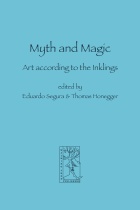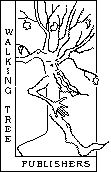Myth and Magic:
Art according to the Inklings
Eduardo Segura & Thomas Honegger (editors)
Cormarë Series No. 14

<--previous | all publications | next-->
how to buy this item
 Myth, magic, art and literary creativity were central topics of discussion among the Inklings. Their common interest in these themes finds expression in their literary as well as critical works, which may thus be put in relation to each other in order to arrive at a more comprehensive understanding of the group’s stance on these issues.
Myth, magic, art and literary creativity were central topics of discussion among the Inklings. Their common interest in these themes finds expression in their literary as well as critical works, which may thus be put in relation to each other in order to arrive at a more comprehensive understanding of the group’s stance on these issues.
This volume contains papers by Inklings-scholars from the USA (Tom Shippey, Verlyn Flieger, Devin Brown), the UK (John Garth, Colin Duriez, Patrick Curry), Switzerland (Dieter Bachmann), Germany (Thomas Honegger) and Spain (Martin Simonson, Eduardo Segura, Eugenio Merino-Olivares, Fernando J. Soto & Marta García de la Puerta, Margarita Carretero-González, Miryam Librán-Moreno) that investigate these topics in the work of individual authors and explore the interconnectedness of these concepts in the thinking of the members of this group.
Recovering the “Utterly Alien Land”:
Tolkien and Transcendentalism
The notion of Recovery, as J.R.R Tolkien explains it in his well-known essay ‘On Fairy-stories’, seems to have eclipsed previous expressions of the same concept, but facts are that the idea was far from being a newcomer on the scene of literary theory and philosophy. It had been previously discussed over many centuries, most notably in Neoplatonic philosophy, Romantic theory and Transcendentalist thinking. However, Tolkien launched the idea from theory to practice in a much more immediate way than that of his predecessors. In the following paper, I will explain Tolkien’s approach to the notion of Recovery both with reference to some of the preceding theoretical and literary expressions of the same urge, and to his particular creativity and story-telling strategies.
New Learning and New Ignorance:
Magia, Goeteia, and the Inklings
Lewis’s most far-reaching academic work, English Literature in the Sixteenth Century, Excluding Drama, opens by arguing that teachers and students often anachronistically introduce modern oppositions into their view of the Renaissance, especially that between magic and science. In this article Lewis’s arguments are considered, and are compared with the images of magic he presented in his fiction, and with those which he shared with his fellow-Inklings, Tolkien and Williams. One thing common to all three is the distinction (variously expressed) between ‘magia’ and ‘goeteia’. It is argued that Lewis in effect attempted to replace James Frazer’s triangle of magic, religion and science, familiar from The Golden Bough, by a more complex opposition between, on the one hand, scientism and goeteia, and on the other, religion and magia. .
Words for Magic: goetia, gûl and lúth
The question of ‘magic’ in The Lord of the Rings is, in Tolkien’s words, “very large, and difficult.” If we are to believe Galadriel, this is merely due to a terminological confusion in mortal tongues. But to Tolkien the philologist, there is no ‘mere’ terminology.
When is a Fairy Story a Faërie Story?
Smith of Wootton Major
Fairy-stories, Tolkien maintained, are not about fairies, but about Faërie, “the realm or state in which fairies have their being.” In his essay ‘On Fairy-Stories’ he maintained that “Most good ‘fairy-stories’ are about the aventures of men in the Perilous Realm.” His last short story, Smith of Wootton Major, exemplifies what in the essay Tolkien meant by Faërie, the essay by explaining, the story by depicting, so that that the story becomes the practical application of the criteria in the essay – the appropriate subject matter, the proper quality, and the threefold face that fairy-stories show their readers. Smith of Wootton Major is thus a Faërie story in Tolkien’s purest sense of that word.
C. S. Lewis’s attempts to capture the real in literature and thought is explored, mainly through how he sees the imagination as the organ of meaning. He has a poetic sensibility that expresses itself best in mythopoeia, the making of myth. For him great stories and myth have, like poetry, the ability to capture universals and qualities in the particular, and as such appeal to an ideal human consciousness that, though lost, we all remember. In fact such stories, he felt, can give us sensations never before experienced; effectively, giving us changes in consciousness. This ability to explore the cosmic and universal through the concrete, he believed, can also be found in historical narrative; that is, through actual rather than fictional events. The epitome of such a marriage of myth and fact is, for Lewis, the Word made flesh – the incarnation of God himself as a human being in the first century. That incarnation, for Lewis, is like the moments when stories and other products of the imagination hold together “the general with the concrete” (Coleridge). The views of Tolkien, Charles Williams and Owen Barfield shed light on Lewis’s quest, especially when seen in the wider context of Romanticism, especially Coleridge and George MacDonald. Reference is made, in particular, to Barfield's Poetic Diction, Tolkien’s ‘On Fairy Stories’, Lewis’s Miracles, and especially relevant essays of Lewis’s including ‘Myth and Fact’, and 'Transposition'.
Tolkien and Weber on Modernity and Enchantment
This paper uses both a conceptual and a symbolic-mythological hermeneutic analysis of their very different work to compare the attitudes and understandings of J.R.R. Tolkien and Max Weber towards modernity. It points to fundamental commonalities and suggests that both men also counterposed modernity with enchantment. It therefore includes a closer consideration of the nature of such enchantment and the meta-politics of its relationship with modernist magic.
Looking a Gift Horse in the Mouth
This paper explores the chequered history of the meta-fictional elements Tolkien employed to create a connection between the (largely Elvish) legends and tales and his ‘Mannish’ (originally English) readership. The early concepts presuppose a direct connection between ‘England’ and the Elvish homelands and make use of elements already central to the ‘national identity’ forming processes in Middle English literature after the Norman conquest. These concepts are, as the work on the Legendarium progressed, superseded by more involved and less explicitly ‘national’ meta-fictional frameworks.
as a Conveyer of Deepest Truth
An examination of C. S. Lewis’s writing and of what he had to say about writing suggests that Lewis saw a necessity for a creative, mythic platform rather than an expository one in order to fully address life's most important issues. His fiction is an attempt to cast what he considered to be fundamental truths into an imaginary world, for it is only in this manner, he maintained, can they “appear in their real potency.”
‘A Kind of Orpheus-Legend in Reverse’:
Two Classical Myths in the Story of Beren and Lúthien
The following essay is an inquiry into the influence of two Greek myths in the shaping of the matter of Beren and Láthien: the myths of Orpheus and Eurydice (Orpheus-legend) and Protesilaus and Laodameia (Protesilaodameia romance).
A Monster that Matters: Tolkien’s Grendel Revisited
The present paper is an attempt to provide a systematic description of how Tolkien conceived Grendel, the hero’s first foe in the Anglo-Saxon poem Beowulf. Although one gets scattered glimpses of Tolkien’s view on Grendel from his letters and, perhaps, from characters in his works of fiction, my analysis will focus mainly on Tolkien’s lecture ‘Beowulf: The Monsters and the Critics’ (November 25, 1936). I will make reference to its definite version, as well as to the previous drafts.
A Tale as Old as Time, Freshly Told Anew:
Love and Sacrifice in Tolkien, Lewis and Rowling
My paper addresses the issue of the importance J.R.R. Tolkien, C.S. Lewis and J.K. Rowling give to the ‘magical’ power of sacrifice as an act of love in their writings. The way they deal with this ancient topic has indeed contributed to the popularity Tolkien and Lewis have been enjoying for the past fifty years and the enormous success of the Harry Potter books. In writing about sacrificial deaths as acts of love, these authors have dressed old myths in new clothes, but the result is, as always in good mythopoeia, much more than “lies […] breathed through silver.”
The Hidden Meanings of the Name ‘Ransom’:
Strange Philology and ‘Contradiction’ in C.S. Lewis’s Cosmic Trilogy
This paper will set out to explore a ‘philological’ aspect of the name ‘Ransom’ in an attempt to give a derivation for Lewis’ literary baptism of the main character in the celebrated Space Trilogy. At the same time, as this paper outlines the hidden meanings of this curious name, these meanings will also be used to explain an apparent ‘contradiction’ between Perelandra and Out of the Silent Planet: one that concerns Ransom’s ‘real’ as opposed to his ‘fictitious’ name.
Visions of War in the Dead Marshes
J.R.R. Tolkien’s letters to his son Christopher during the writing of Book Four of The Lord of the Rings in 1944 make it possible, as nowhere else, to scrutinise the early stages of its composition in the context of the author’s contemporaneous experiences. Such an analysis reveals that, contrary to allegations of escapism, Tolkien’s writing reflected or refracted day-to-day concerns in his life and the world around him. Scrutiny of ‘The Passage of the Marshes’ uncovers the shaping influence of Tolkien’s feelings about the Second World War, then raging, and the First, memories of which had been newly stirred by a visit to his Birmingham school. The chapter is revealed as a mature literary product of the trench experience to rival the work of canonical First World War writers such as Siegfried Sassoon and Wilfred Owen.
Leaf by Niggle and the Aesthetics of Gift:
Towards a Definition of J.R.R. Tolkien’s Notion of Art
G.K. Chesterton’s Orthodoxy includes a memorable chapter titled ‘The Ethics of Elfland’. The text was initially written as a preface to Andrew Lang’s Violet Fairy Book. What lies beneath such a suggestive title is the conviction that there is a deep resemblance between Faërie and our world — or, to use Tolkien’s terminology, between secondary worlds and the Primary World. More precisely, we should say that Chesterton and Tolkien agreed that the world we call ‘real’ – for lack of a better word – looks like a mirror where invented, consistent worlds become images of the multiplicity of Truth – as “refracted light” (see Segura 1997). It is my purpose to show what Tolkien thought about his art, the theoretical process of his discovery of a new world through the invention of languages, and the shaping of his personal poetics on the basis of his conversations with the Inklings, and more specifically with Owen Barfield and C.S. Lewis, through a careful reading of Leaf by Niggle — the reputedly most allegorical of Tolkien’s short stories.
352 pages, Walking Tree Publishers 2007, Cormarë Series No. 14, Editors: Eduardo Segura & Thomas Honegger
, ISBN: 978-3-905703-08-5.

<--previous | all publications | next-->
how to buy this item

More on Myth and Magic: Art according to the Inklings

terms and conditions
visitors since 05.11.07
last updated 14.11.07
